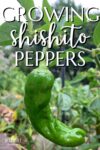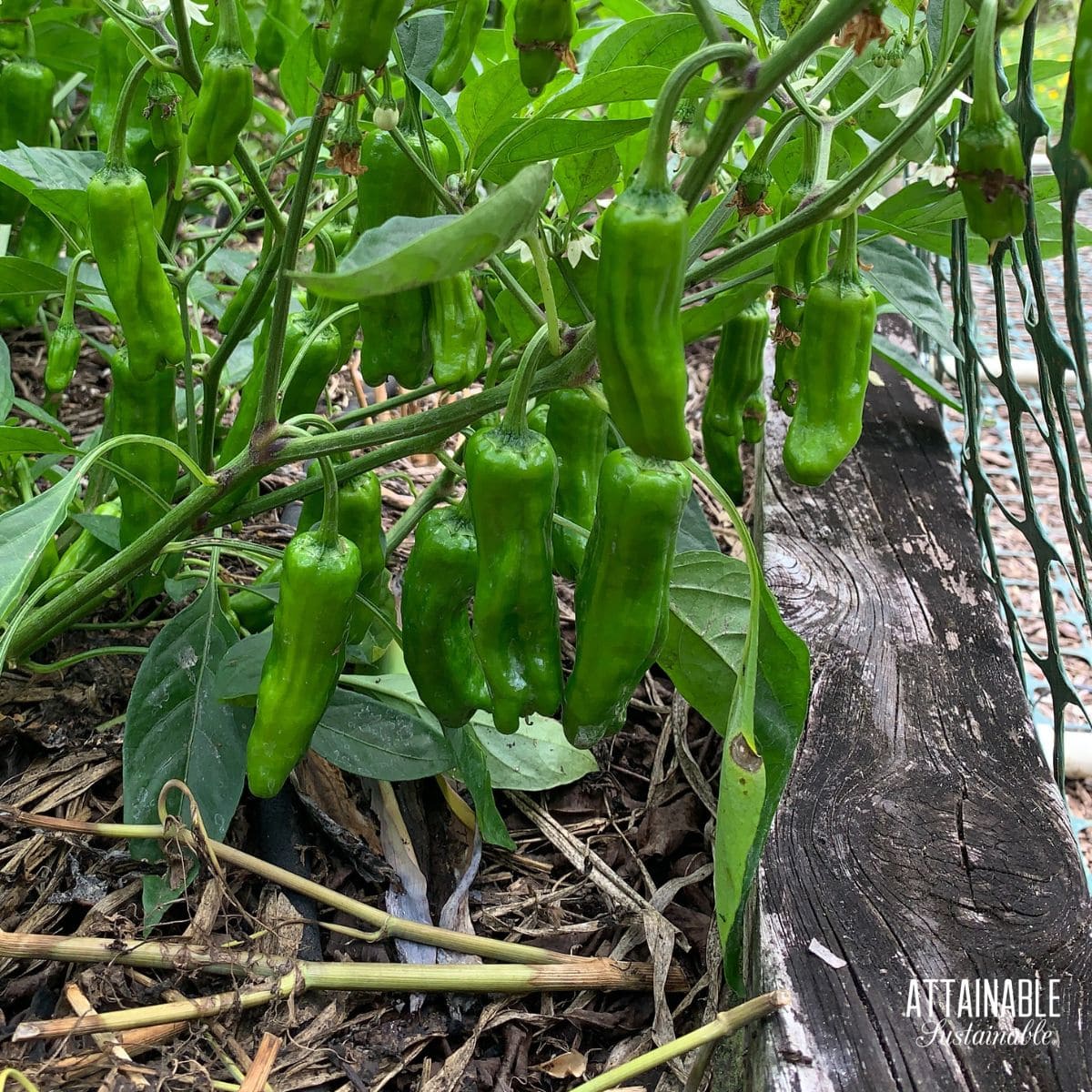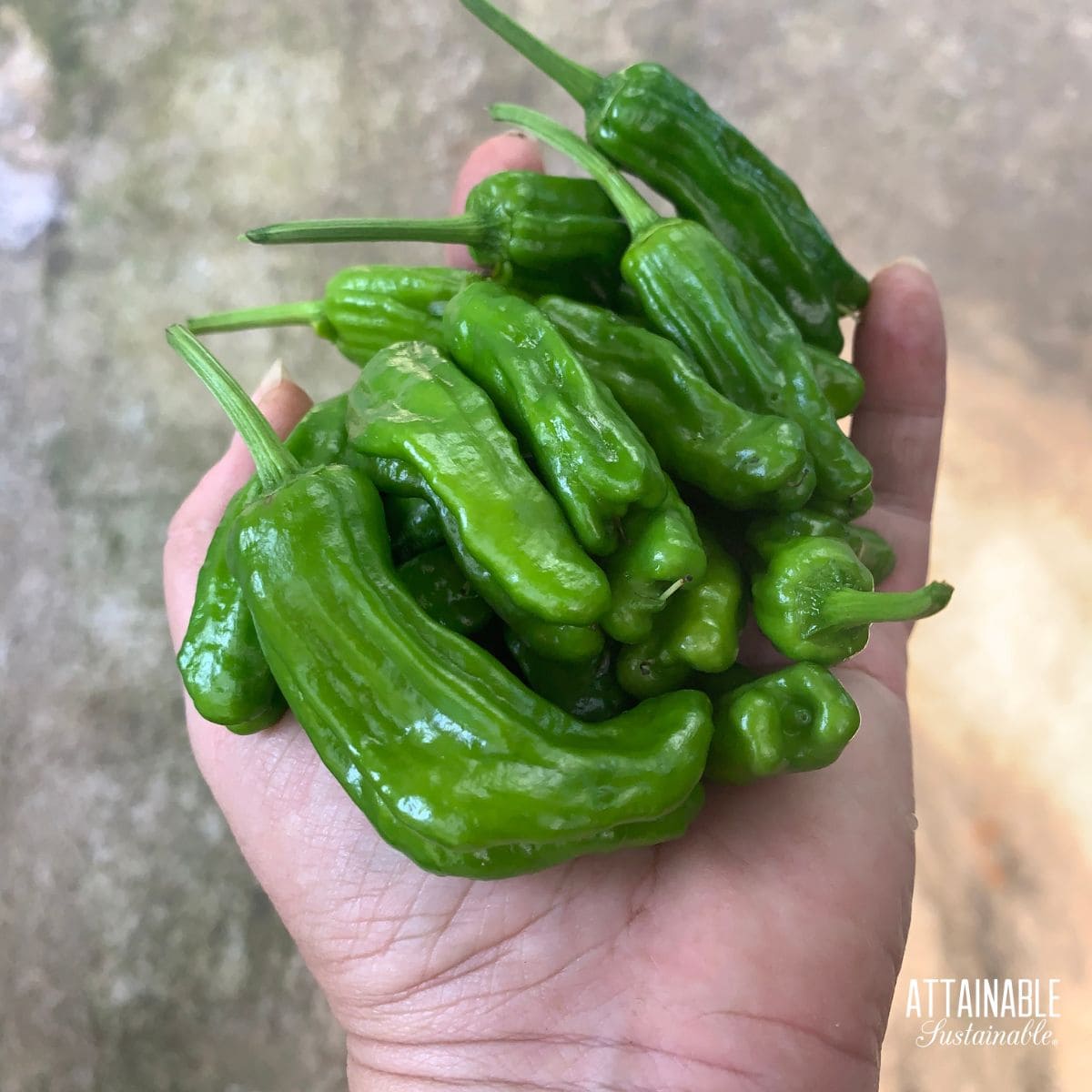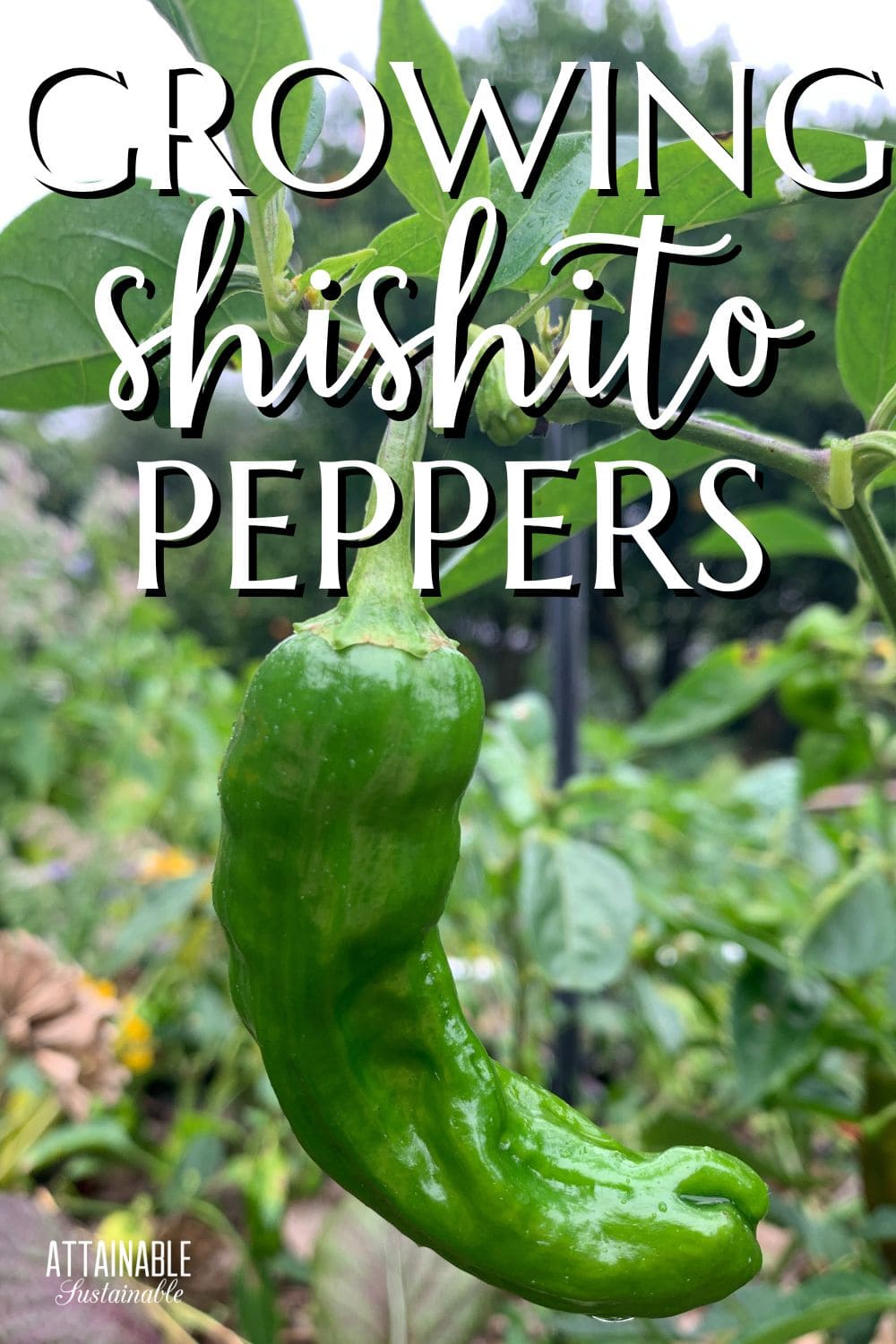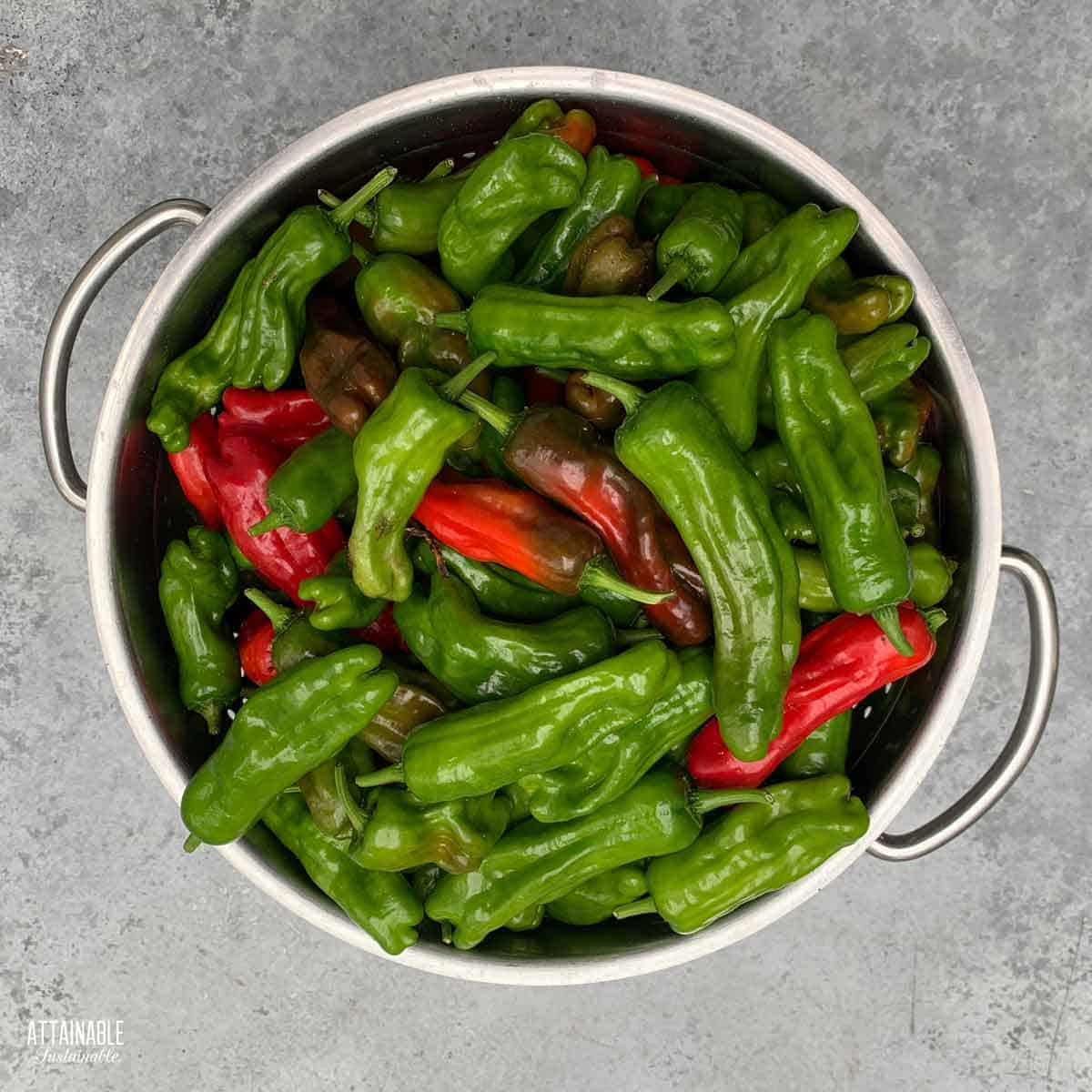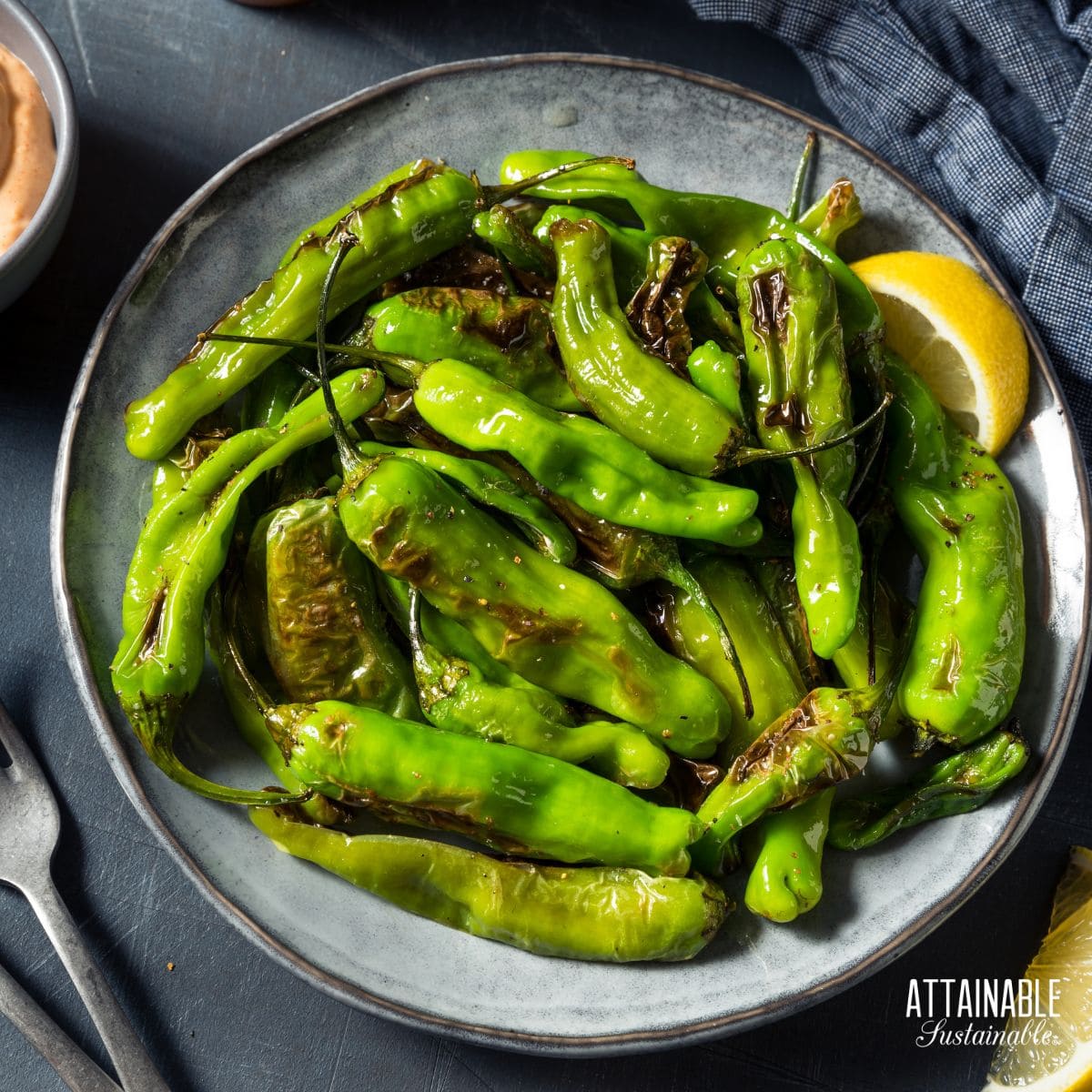Shishito peppers are a mild pepper that have begun to make an appearance on restaurant menus as a roasted appetizer. You can replicate that flavor at home all summer long when you grow shishito pepper plants in your vegetable garden!
Getting to Know Shishito Peppers
Shishito peppers are from the Capsicum family, which includes both sweet peppers and hot peppers. These elongated peppers have a somewhat wrinkly skin and are prolific in the garden. I plant shishito peppers every year now in my raised bed garden and they produce all summer long.
One in ten peppers may be mildly spicy, but I’ve found that to be a rarity. They have a mild, slightly nutty flavor. They barely register on the scoville scale, running from about 50-200 scoville heat units. For comparison, jalapeño peppers can range from about 2,500-8,000 on the same scale.
While I do not really enjoy green bell peppers, I can devour a plate of these savory peppers!
Pepper plants — sometimes called chile peppers or (spelled differently) chili peppers — are nice enough looking that they can be added to a front yard edible garden with nobody the wiser!
These peppers grow on a compact plant that reaches about two feet tall.
Grow Some Greens!
Ready to grow fresh greens, no matter WHERE you live? Sign up for my
FREE quick-start guide and start growing some of your own food!
Starting Seeds Indoors
Shishito peppers are propagated from seed. You may find seedlings ready for the garden at nurseries, but availability can be hit or miss. Germinating your own shishito pepper seeds assures that you’ll have the seedlings you want to grow in your garden.
Start pepper seeds indoors about 8 to 10 weeks before your last frost date. (Read more about seed starting here.) Check the seed packet for specific requirements.
Pepper seeds should be surface sown or just barely covered with soil; they need a bit of light in order to germinate. Give the seeds a head start and soak them before planting.
Place seed trays or pots on a seedling heat mat to maintain the proper soil temperatures. The ideal temperature range is between 75 and 85 degrees Fahrenheit.
If you don’t have a heat mat for starting vegetables, try germinating pepper seeds in your Instant Pot!
Once the seedlings emerge, give the pepper seedlings supplemental full spectrum lighting under a grow light. This will ensure that the plants don’t become spindly and weak while growing indoors.
When the plants have two sets of true leaves, transplant them into individual 2″ pots. Use an enriched, organic potting mix in your seedling pot. Keep the pots watered well; if the potting soil dries out the plants will be stunted.
If the seedlings begin to outgrow the 2″ pots, you can move them up to a larger container while you wait for the temperatures to allow for outdoor, in-ground planting.
At this point, you can also plant the seedlings into a large planter, if you’re a container gardener. Keep the potted pepper inside until the weather cooperates. If you have warm days and cold nights, you can set the pots out during the day and move them back in for protection at night.
Moving Pepper Seedlings Out to the Garden
Transplant seedlings — whether homegrown or those purchased from a garden center — outdoors in early spring when all risk of frost has passed and nighttime temperatures remain above 50°F.
Shishito pepper plants grow best between 65° and 85°F. If cold weather threatens after you’ve planted the seedlings in your home garden, cover them to protect them from frost damage. You can use a plastic bottle cloche if the plants are small enough, or drape the plant with a row cover or frost cloth overnight.
If the blossoms are dropping off your plant, the daytime temperatures may be too hot for pollination. If your peppers are in containers, try moving them to a shady spot until the day time temperatures moderate. Keep the soil moist but not dripping.
Pinch the tips of the plant back to cause the plant to branch out and become more bushy. This extra leafiness protects the developing fruit from sunscald.
If you live in a warm, frost-free climate, peppers can be grown as short lived perennials once you get them started.
Requirements for Growing Peppers
Light Requirements
Peppers are a crop that needs full sun. Plan for between 6-8 hours of direct sunlight each day during the prime growing season for your region.
Soil and Fertilizer Requirements
Peppers need warm soil with good drainage. Add one cup of complete organic fertilizer to the planting hole. Transplant pepper seedlings, maintaining the depth of the original pot. Check with your area’s Cooperative Extension office to see about specific recommendations for your garden’s soil.
While plants are growing, you may need to fertilize periodically. Side dress with compost about a month after planting and then every few weeks.
Water Requirements
How often to water shishito pepper plants depends on so many factors, primarily temperature, soil, and whether the plant is grown in-ground or in a container.
To grow healthy pepper plants, water regularly to keep the soil moist, but not soggy. To check, poke your finger a couple of inches into the soil and see if you can feel any moisture. If it feels like a damp, wrung out sponge, it doesn’t need water, but should be checked the next day.
Plants grown in the ground can usually go a week between watering, unless it’s really hot. Container grown peppers will likely need to be watered every couple of days at a minimum.
A layer of mulch placed around the base of the plant helps to maintain soil moisture and keep down weeds.

Leafhopper adults and nymphs can cause damage to pepper plants.
Common Pests
Peppers often have the same insect pest and disease problems as tomatoes and eggplant. Maintain good watering practices, because plants will stop flowering and fruiting if they experience dry conditions.
Controlling insect vectors can minimize damage when growing shishito peppers, as the spores travel between plants on the feet of insects.
Cutworms are a risk to young seedlings. These caterpillars live underground an emerge at night to chew through the base of young plants. Placing a protective ring around seedlings can help, as can diatomaceous earth. If you see cutworm damage, use a chopstick to gently disturb the soil around the plant and look for the curled “C” of the cutworm to remove them manually.
Leafhoppers and tree hoppers are attracted to peppers and can cause stem damage to mature plants.
Prevent problems with soil diseases, like verticillium wilt, by rotating where you plant peppers and avoid planting where tomatoes, eggplant, and potatoes have grown in the last 2 or 3 years.
Place peppers where sunlight and wind can dry the leaves naturally and inhibit the spread of fungal spores. If you see signs of mildew on the leaves, spraying the plant with diluted, full fat yogurt, kefir, or whey can arrest the progression of mildew.
How to Grow Shishito Peppers in a Pot
Shishito plants don’t need a lot of space to grow; they’re a great addition to a container garden. Use a pot or window box that is at least 10 inches deep, with a minimum 2-gallon capacity. They can work well in a grow bag, too.
If you live in a warm climate that tends to be dry in summer, a larger pot will need to be watered less frequently, saving you time and energy.
Fill your containers with a potting mix enriched with organic matter. Add ½ to 1 cup of complete organic fertilizer to each pot. Water peppers well after transplanting. Keep pepper plants evenly moist during the growing season. Peppers don’t like to dry out.
Harvesting
Shishito pepper plants will continue to flower and produce fruit until the nighttime temperatures dip below 50°F.
Start harvesting shishito peppers when the fruit reaches its full size (three to four inches or so), though small peppers (2″ long) are fully edible if you get anxious to try them. Allowed to hang on the plant longer, the the green peppers will further ripen into red shishito peppers, which can be hotter than the green stage. These peppers are edible at either stage.
Check your seed packet, but you can usually harvest shishito peppers about 60 days after transplanting seedlings out into the garden.
When the peppers are ripe, use handheld pruners to clip each one from the plant.
Saving Seeds
Shishitos are heirloom peppers, so you can save seeds to plant again the following season.
Cut red, fully ripe peppers open and scrape out the seeds. Allow them to dry completely and store in a cool, dry place.
I’ve had great germination rates saving seeds from my own shishito pepper plant.
Overwintering Shishito Pepper Plants
If you’re growing pepper plants in containers, you can extend the season by moving the plants to a sunny spot inside. when cold temperatures threatens.
Plants grown in the ground can be dug up and potted for the winter months.
It’s unlikely that you’ll see much of a harvest from peppers during the winter months unless you provide greenhouse-like conditions, but moving plants indoors means that come springtime you’ll have fully mature plants to set out and you’ll be enjoying the mild flavor or these peppers before they become available at local farmers markets.
Using Shishito Peppers in Recipes
Hands down, our favorite way to enjoy these mild peppers is to sear them with a little olive oil and sea salt. Heat a cast iron pan, add a bit of olive oil, then add peppers so they are in a single layer. Sprinkle with salt and cook over high heat, turning peppers until all sides are lightly browned.
For larger batches, place peppers in a single layer on a rimmed baking sheet and toss with olive oil and sea salt. Roast in a 400 degree oven for 15 minutes or so, turning occasionally, until peppers are seared on all sides and softened.
You can cut off the stem end, or leave it on to use as a little handle when serving as appetizers or an easy side dish. Just pop the whole pepper in your mouth!
These recipes are going on my “must try” list to use these little peppers:
FAQs
Can I eat shishito peppers raw?
Absolutely. Though it is more common to eat them blistered, roasted, or grilled. The seeds of fresh shishito peppers are fully edible, too.
How many peppers will one shishito pepper plant produce?
A lot! These plants produce continually throughout the season. A healthy plant will produce a dozen or more mature fruit every few days throughout the summer months.
Are shishito peppers and padron peppers the same?
They are very similar in appearance and often served the same way (blistered and roasted). Both are from the cultivar Capsicum annuum var. annuum. But while shishito peppers have roots in east Asia, Padron peppers are a cultivar from Padrón in northwestern Spain.
